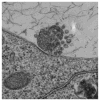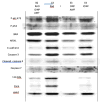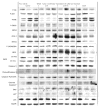Effect of intra-tumoral magnetic nanoparticle hyperthermia and viral nanoparticle immunogenicity on primary and metastatic cancer
- PMID: 29203952
- PMCID: PMC5711520
- DOI: 10.1117/12.2256062
Effect of intra-tumoral magnetic nanoparticle hyperthermia and viral nanoparticle immunogenicity on primary and metastatic cancer
Abstract
Although there is long association of medical hyperthermia and immune stimulation, the relative lack of a quantifiable and reproducible effect has limited the utility and advancement of this relationship in preclinical/clinical cancer and non-cancer settings. Recent cancer-based immune findings (immune checkpoint modulators etc.) including improved mechanistic understanding and biological tools now make it possible to modify and exploit the immune system to benefit conventional cancer treatments such as radiation and hyperthermia. Based on the prior experience of our research group including; cancer-based heat therapy, magnetic nanoparticle (mNP) hyperthermia, radiation biology, cancer immunology and Cowpea Mosaic Virus that has been engineered to over express antigenic proteins without RNA or DNA (eCPMV/VLP). This research was designed to determine if and how the intra-tumoral delivery of mNP hyperthermia and VLP can work together to improve local and systemic tumor treatment efficacy. Using the C3H mouse/MTG-B mammary adenocarcinoma cell model and the C57-B6 mouse/B-16-F10 melanoma cancer cell model, our data suggests the appropriate combination of intra-tumoral mNP heat (e.g. 43°C/30-60 minutes) and VLP (100 μg/200 mm3 tumor) not only result in significant primary tumor regression but the creation a systemic immune reaction that has the potential to retard secondary tumor growth (abscopal effect) and resist tumor rechallenge. Molecular data from these experiments suggest treatment based cell damage and immune signals such as Heat Shock Protein (HSP) 70/90, calreticulin, MTA1 and CD47 are potential targets that can be exploited to enhance the local and systemic (abscopal effect) immune potential of hyperthermia cancer treatment.
Keywords: abscopal effect; cancer therapy; hyperthermia; immunotherapy; magnetic nanoparticle; viral-like nanoparticle (VLP).
Figures
Similar articles
-
Hypo-fractionated Radiation, Magnetic Nanoparticle Hyperthermia and a Viral Immunotherapy Treatment of Spontaneous Canine Cancer.Proc SPIE Int Soc Opt Eng. 2017 Jan-Feb;10066:1006605. doi: 10.1117/12.2256213. Epub 2017 Feb 22. Proc SPIE Int Soc Opt Eng. 2017. PMID: 29203951 Free PMC article.
-
The effect of hypofractionated radiation and magnetic nanoparticle hyperthermia on tumor immunogenicity and overall treatment response.Proc SPIE Int Soc Opt Eng. 2017;10066:100660D. doi: 10.1117/12.2255981. Epub 2017 Feb 23. Proc SPIE Int Soc Opt Eng. 2017. PMID: 29515284 Free PMC article.
-
Treatment of Canine Oral Melanoma with Nanotechnology-Based Immunotherapy and Radiation.Mol Pharm. 2018 Sep 4;15(9):3717-3722. doi: 10.1021/acs.molpharmaceut.8b00126. Epub 2018 Apr 12. Mol Pharm. 2018. PMID: 29613803 Free PMC article.
-
Local tumour hyperthermia as immunotherapy for metastatic cancer.Int J Hyperthermia. 2014 Dec;30(8):531-9. doi: 10.3109/02656736.2014.968640. Int J Hyperthermia. 2014. PMID: 25430985 Free PMC article. Review.
-
Recent Progress in the Synergistic Combination of Nanoparticle-Mediated Hyperthermia and Immunotherapy for Treatment of Cancer.Adv Healthc Mater. 2021 Jan;10(2):e2001415. doi: 10.1002/adhm.202001415. Epub 2020 Nov 25. Adv Healthc Mater. 2021. PMID: 33236511 Free PMC article. Review.
Cited by
-
Magnetic systems for cancer immunotherapy.Acta Pharm Sin B. 2021 Aug;11(8):2172-2196. doi: 10.1016/j.apsb.2021.03.023. Epub 2021 Apr 30. Acta Pharm Sin B. 2021. PMID: 34522583 Free PMC article. Review.
-
Heating Induced Nanoparticle Migration and Enhanced Delivery in Tumor Treatment Using Nanotechnology.Bioengineering (Basel). 2024 Sep 7;11(9):900. doi: 10.3390/bioengineering11090900. Bioengineering (Basel). 2024. PMID: 39329642 Free PMC article. Review.
-
Hyperthermia: The Optimal Treatment to Overcome Radiation Resistant Hypoxia.Cancers (Basel). 2019 Jan 9;11(1):60. doi: 10.3390/cancers11010060. Cancers (Basel). 2019. PMID: 30634444 Free PMC article. Review.
-
Inactivated Cowpea Mosaic Virus for In Situ Vaccination: Differential Efficacy of Formalin vs UV-Inactivated Formulations.Mol Pharm. 2023 Jan 2;20(1):500-507. doi: 10.1021/acs.molpharmaceut.2c00744. Epub 2022 Nov 18. Mol Pharm. 2023. PMID: 36399598 Free PMC article.
-
Cowpea Mosaic Virus Outperforms Other Members of the Secoviridae as In Situ Vaccine for Cancer Immunotherapy.Mol Pharm. 2022 May 2;19(5):1573-1585. doi: 10.1021/acs.molpharmaceut.2c00058. Epub 2022 Mar 25. Mol Pharm. 2022. PMID: 35333531 Free PMC article.
References
-
- Jordan A, et al. The effect of thermotherapy using magnetic nanoparticles on rat malignant glioma. Journal of Neuro-Oncology. 2006;78(1):7–14. - PubMed
-
- Maier-Hauff K, et al. Intracranial Thermotherapy using Magnetic Nanoparticles Combined with External Beam Radiotherapy: Results of a Feasibility Study on Patients with Glioblastoma Multiforme. Journal of Neuro-Oncology. 2006;81(1):53–60. - PubMed
-
- Johannsen M, et al. Morbidity and quality of life during thermotherapy using magnetic nanoparticles in locally recurrent prostate cancer: Results of a prospective phase I trial. International Journal of Hyperthermia. 2007;23(3):315–323. - PubMed
Grants and funding
LinkOut - more resources
Full Text Sources
Other Literature Sources
Research Materials
Miscellaneous




















